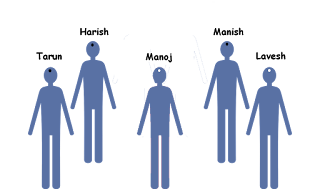But what was the puzzle?
Let's recall the definition of the probability. It's ratio of number of desired combinations to the number of total possible combinations.
A Rook and Bishop can have 64 Permutations 2 = 64 X 63 = 4032 possible combinations on a standard chess board if placed randomly.
Now there are 2 possible cases - The Rook attacking Bishop and the Bishop attacking Rook. Both can't attack each other simultaneously.
CASE 1 : The Rook attacking the Bishop
The Rook can have 64 possible positions on the chess board and for every position it attacks 14 other position in it's attacking lines. That means 64 X 14 = 896 possible combinations where Rook is attacking Bishop.
CASE 2 : The Bishop attacking the Rook
Now imagine 4 hallow co-centrist squares around the center of the chess board with outermost have side 8 units & innermost having side 2 units.(See below)
Here each square has side with thickness of 1 unit.
If the Bishop is anywhere on outermost square which has 28 possible positions then it attack 7 other positions.( See below pics).
So there are 28 x 7 = 196 possible combinations where Bishop attacking the Rook.
--------------------------------------------------------------------------
Now if the bishop is anywhere on 20 squares of inner square then 9 other positions will be in it's attacking lines. (See below).
In this way, there will be 20 X 9 = 180 such combinations where the bishop will attack the rook.
--------------------------------------------------------------------------
Now if the Bishop is placed anywhere on the 12 squares of more inner square then 11 other positions will be in it's lines of attack.( See below).
In short, there are 12 X 11 = 132 combination where Bishop will be attacking the rook.
--------------------------------------------------------------------------
And finally, if the bishop is placed at any of 4 positions of the innermost square then it will attack 13 other positions like below.
That is, there will be 4 X 13 = 52 such combinations where the Bishop will be attacking the Rook.
-------------------------------------------------------------------------------
Adding all possible combinations of CASE 1 and CASE 2 as - 896 + 196 + 180 + 132 + 52 = 1456. It means there are 1456 possible combinations where either the Rook attacking Bishop or Bishop attacking the Rook.
The Required Probability = Number of Required Combinations / Number of Total Combinations = 1456 / 4032 = 0.3611
To conclude, 0.3611 is the probability that the Rook or Bishop attacking each other if place randomly on standard chess board.
NOTE : Don't get confused with black Bishop on black square used in illustrations of attacking lines in CASE 2. Even if it was black Bishop on white square then also it would attack same other positions mentioned in that particular consideration. And random placement means it could be anything - on black or on white.





























